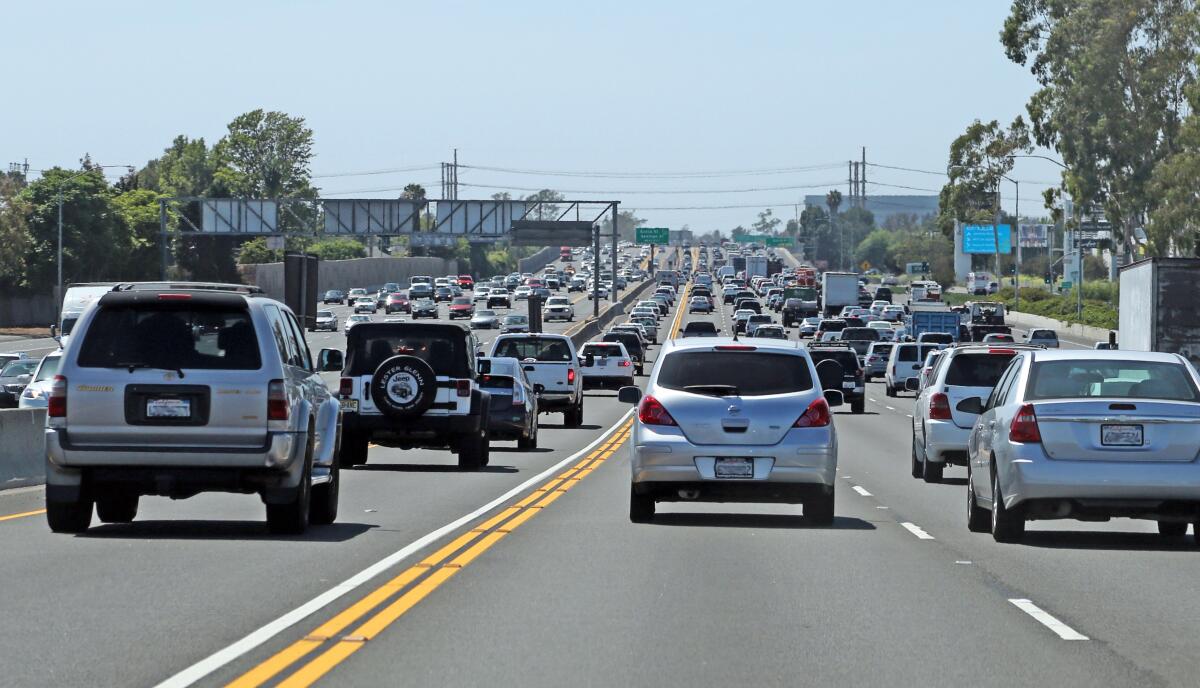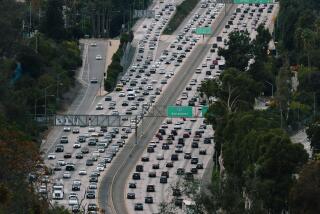Drivers on the 405 Freeway in O.C. could pay $10 tolls, get extra lanes. Would it help with traffic?

- Share via
Commuters on the 405 Freeway in Orange County could soon be driving in new lanes and paying tolls of nearly $10 to use the express lanes during peak hours.
But some experts raised doubts that expanding the freeway could mitigate traffic.
The project will span 16 miles between Costa Mesa and the L.A. County line and add one regular lane in each direction, said Orange County Transportation Authority spokesperson Joel Zlotnik. It will also add a second lane that combines with the existing carpool lane to create the 405 Express Lanes.
The proposed toll policy for the 405 Express Lanes is expected to be considered by the OCTA board on July 24 and unveiled at the end of 2023.
Under the policy, there will be no tolls for carpools with three or more people, motorcycles or vehicles with designated veterans license plates, or disabled person license plates. Clean air vehicles will have a 15% discount.
Carpools with two people can use the lanes without paying in the first three and a half years during non-peak hours, which are outside the hours of 6 to 10 a.m. and 2 to 7 p.m. Monday through Friday and outside of 1 to 7 p.m. Saturday and Sunday. Solo drivers and two-person carpools would always have to pay a toll during peak hours.
Tolls would depend on the day of the week, hour, direction of travel and distance traveled. The maximum toll rate for the entire drive is $9.95 and the minimum is $2.70. Drivers will be required to have transponders in order to use the express lanes.
“Another important part of this project is that we rebuilt 18 bridges that span the 405,” Zlotnik said. “On those bridges that connect to local streets and roads, we’ve added bike lines and improved on- and off-ramps to the freeway. The express lanes give people the choice when they absolutely have to get somewhere.”
Toll rates will be reviewed and adjusted on a quarterly basis, Zlotnik said. The money will go toward paying the $629-million federal loan that the OCTA received to construct the express lanes.
Critics of freeway expansion projects cite the need to combat climate change and air pollution, the legacy of displacing and polluting communities of color and research that shows that expanding freeways doesn’t alleviate traffic congestion.
Last year, the Los Angeles County Metropolitan Transportation Authority voted to scrap a $6-billion plan to widen the 710 Freeway.
The Times has found that over three decades, more than 200,000 people nationally lost their homes because of federal road projects.
A 2009 study found that increasing road capacity in metropolitan areas by 1% eventually results in an increase in cars on the road by 1%.
Brown University economics professor Matthew Turner, who co-authored the study, said that widening highways or adding lanes isn’t an effective way to combat traffic.
“If the object of building roads is to reduce traffic congestion, then what the results suggest is that you’re going to fail,” he said.
Instead, he said that increasing toll pricing at peak hours, as is proposed for the 405 Express Lanes, could turn a traffic jam into free flow speeds by reducing the cars on the road by as little as 5%.
“Getting pricing programs in place is really hard,” he said. “I think a quirk of human nature is people don’t like to pay for things that they used to have for free. That’s a big hurdle.”
Daniel Chatman, a professor of city and regional planning at UC Berkeley, said the theory behind “induced demand” is that once highways are expanded, more vehicles will show up because they believe that the additional lanes have reduced the congestion.
“If the same number of travelers would take the route before the change as they did after the change, congestion would definitely go down,” he said. “I think what policymakers may or not realize is that especially over time, people will change their routes and change their times of day and change their modes in order to use the new facility.”
In the short term, however, the express lanes, especially because they include congestion tolls, have the potential to reduce traffic, Chatman said.
“The fact that one of the lanes is going to be congestion-managed is helpful in terms of making it less likely for there to be congestion,” he said. “Depending on how that charge is administered, that lane may be an uncongested lane depending on compliance and enforcement.”
Dave Amos, a professor at Cal Poly’s City and Regional Planning Department, said that although OCTA officials believe the project will allow the county to “keep pace with expected job, housing and population growth,” people shouldn’t rely on just one source for projections on traffic increases.
“These are folks who are incentivized to build more highways,” he said. “You can’t take those numbers at face value. They might not be wrong, but they also might be.”
Amos said the challenges to curbing traffic are reflective of the Los Angeles area developing its transit network around highways, and that it’s difficult to scale highways to growing populations.
“You can’t add lanes indefinitely,” he said. “We’re living in a world where climate equity is more of a concern and a lot of freeways, including the 405, were built around low-income people of color, and the people building this freeway are doubling down on that decision. That comes with more noise, reduced property values that depresses the local economy and is endorsing the policies of the past that are racist and classist.”
More to Read
Sign up for Essential California
The most important California stories and recommendations in your inbox every morning.
You may occasionally receive promotional content from the Los Angeles Times.











